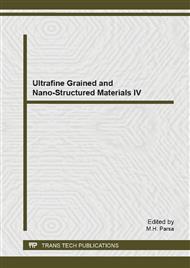[1]
D. Rebolj, M. Fischer, D. Endy, T. Moore, A. Šorgo, Can we grow buildings? Concepts and Requirements for Automated Nano - to Meter-Scale Building, Adv. Eng. Inform., 25 (2) (2011) 390–398.
DOI: 10.1016/j.aei.2010.08.006
Google Scholar
[2]
M. Golabchi, K. Taghizade, E. Sorooshnia, Nanotechnology in Architecture and Construction Engineering, University of Tehran, Iran, (2012).
Google Scholar
[3]
M. Mahdavinejad, S. Mansoori, Architectural Design Criteria of Socio-Behavioral Approach toward Healthy Model, Procedia-Social and Behavioral Sciences 35 (2012) 475-482.
DOI: 10.1016/j.sbspro.2012.02.113
Google Scholar
[4]
M. Mahdavinejad, M. Bemanian, G. Abolvardi, S. M. Elhamian, Analyzing the State of Seismic Consideration of Architectural Non-Structural Components (ANSCs) in Design Process (based on IBC). International Journal of Disaster Resilience in the Built Environment, 3 (2), (2012).
DOI: 10.1108/17595901211245224
Google Scholar
[5]
M. Mahdavinejad, A. Moradchelleh, Problems and Tendencies of the Development of the Architectural Sciences: Culture Research Aspect, Middle-East J. Sci. Res., 10 (6), (2011) 677-682.
Google Scholar
[6]
M. Mahdavinejad, A. Doroodgar, A. Moradchelleh, The Impacts of Revivalist Trends on the Contemporary Architecture of Iran (1977-2011), Middle-East J. Sci. Res., 11 (2) , (2012) 176-183.
Google Scholar
[7]
M. Mahdavinejad, M. Bemanian, M. Hajian, N. Pilechiha, Usage of Indigenous Architectural Patterns for Manufacturing Industrial Housing, Case: Renovation Project of Odlajan of Tehran, Iran, Advanced Materials Research, 548 (2012) 875-879.
DOI: 10.4028/www.scientific.net/amr.548.875
Google Scholar
[8]
M. Mahdavinejad, S. Ahmadzadeh Siyahrood, M. Ghasempourabadi, M. Poulad, M., Development of Intelligent Pattern for Modeling a Parametric Program for Public Space (Case study: Isfahan, Mosalla, Iran), Applied Mechanics and Materials, 220-223 (2012).
DOI: 10.4028/www.scientific.net/amm.220-223.2930
Google Scholar
[9]
M. Mahdavinejad, S. Matoor, N. Feyzmand, A. Doroodgar, Horizontal Distribution of Illuminance with Reference to Window Wall Ratio (WWR) in Office Buildings in Hot and Dry Climate, Case of Iran, Tehran, Applied Mechanics and Materials, 110-116 (2012).
DOI: 10.4028/www.scientific.net/amm.110-116.72
Google Scholar
[10]
P.V. Broekhuizen, F.V. Broekhuizen, R. Cornelissen, L. Reijnders. Use of nanomaterials in the European construction industry and some occupational health aspects thereof. Springer Science and Business Media B.V. (2011).
DOI: 10.1007/s11051-010-0195-9
Google Scholar
[11]
P. Alvarez, J. Lee. Nanomaterials Poised for Big Impact in Construction. Rice University's. 29 Jul (2010).
Google Scholar
[12]
J. Lee, S. Mahendra, P.J. Alvarez. Nanomaterials in the Construction Industry: A Review of Their Applications and Environmental Health and Safety Considerations. Department of Civil & Environmental Engineering, Rice University, Houston, Texas 77005 and Department of Civil and Environmental Engineering, University of California, Los Angeles, California 90095, (2010).
DOI: 10.3934/matersci.2017.4.847
Google Scholar
[13]
Smart Nano-materials in Construction Industry, Access on <URL: /theconstructor. org>.
Google Scholar
[14]
M. C. Daniel, D. Astruc, Gold Nanoparticles: Assembly, Supramolecular Chemistry, Quantum-Size-Related Properties, and Applications toward Biology, Catalysis, and Nanotechnology. CHEM REV, (2004) 104, 293–346.
DOI: 10.1021/cr030698+
Google Scholar
[15]
A. S. Arico, P. Bruce, B. Scrosati, J. M. Tarascon, W. V. Schalkwijk, Nanostructured Materials for Advanced Energy Conversion and Storage Devices. NAT MATER, 4 (2005) 366–377.
DOI: 10.1038/nmat1368
Google Scholar
[16]
R. Olar, Nanomaterials and Nanotechnologies for Civil Engineering, Technical University of Iaşi, Faculty of Civil Engineering and Building Service. (2011).
Google Scholar
[17]
M. Holman, Nanomaterial Forecast: Vol. s and Applications. In ICON Nanomaterial Environmental Health and Safety Research Needs Assessment; Lux Research: Houston, TX, (2007).
Google Scholar
[18]
S. Mann, Nanotechnology and Construction. Nanoforum Report May 30, (2006).
Google Scholar
[19]
W. Zhu, P. J. M. Bartos, A. Porro, Application of Nanotechnology in Construction Summary of a State-ofthe- Art Report. MATER STRUCT, 37 (2004) 649–658.
DOI: 10.1007/bf02483294
Google Scholar
[20]
M. Holman, Nanomaterial Forecast: Vol. s and Applications in ICON Nanomaterial Environmental Health and Safety Research Needs Assessment; Lux Research: Houston, TX, (2007).
Google Scholar
[21]
J. Lee, S. Mahendra, P. J. Alvarez, Potential Environmental Impacts of Nanomaterials Used in the Construction Industry. In Nanotechnology in Construction -3; Bittnar, Z., Zeman, J., Nemecek, J., Smilauer, V., Bartos, P. J. M., Eds.; Springer Verlag: Berlin (2009).
DOI: 10.1007/978-3-642-00980-8_1
Google Scholar
[22]
Z. Ge, Z. Gao, Applications of Nanotechnology and Nanomaterials in Construction, First International Conference on Construction In Developing Countries (ICCIDC–I) Advancing and Integrating Construction Education, Research & Practice, August 4-5, 2008, Karachi, Pakistan.
Google Scholar
[23]
Y. Gogotsi, Nanomaterials Handbook. Taylor & Francis Group, LLC, (2006) 1-2.
Google Scholar
[24]
J. Lee, S. Mahendra, P. Alvarez, Nanomaterials in the Construction Industry: A Review of their Applications and Environmental Health and Safety Considerations. ACS NANO, 4 (7) (2010) 3580-3590.
DOI: 10.1021/nn100866w
Google Scholar
[25]
M. Mahdavinejad, M. Bemanian, N. Khaksar, Gh. Abolvardi, Choosing Efficient Types of Smart Windows in Tropical Region Regarding to Their Advantages and Productivities, International Conference on Intelligent Building and Management, Proc . of CSIT vol. 5 (2011).
Google Scholar


